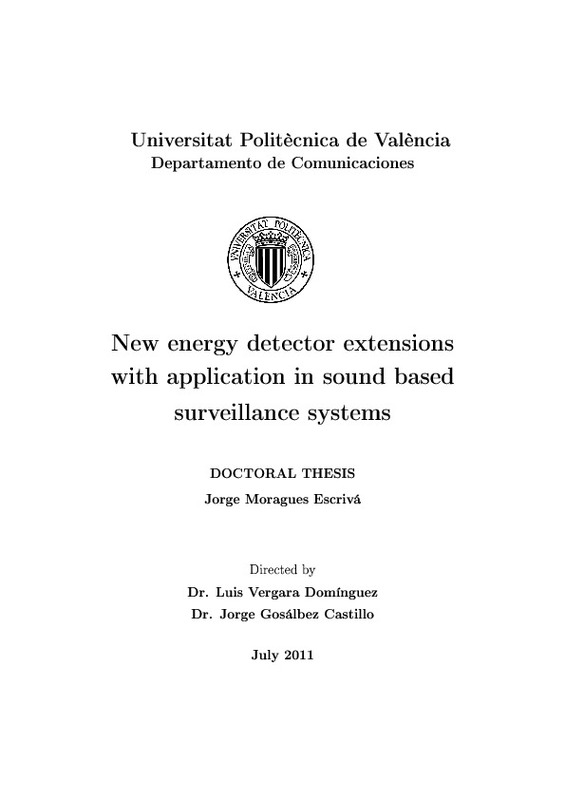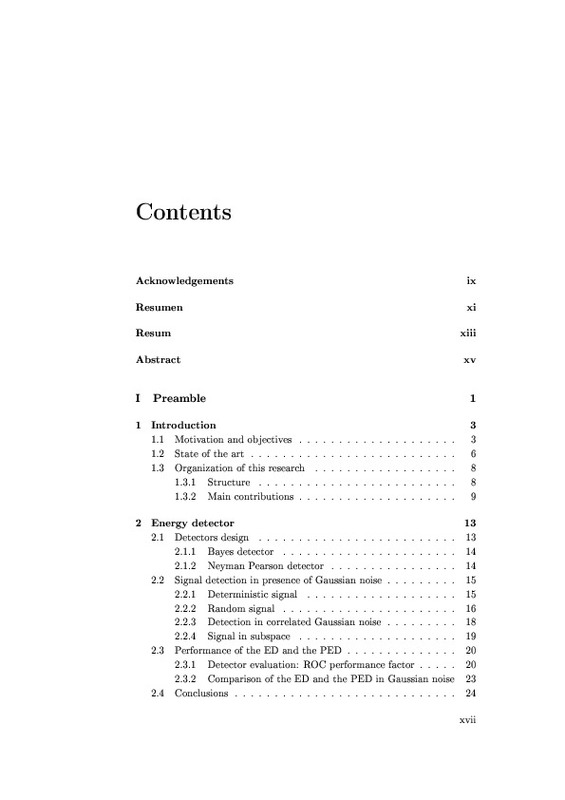- RiuNet repositorio UPV
- :
- Investigación
- :
- Tesis doctorales
- :
- Ver ítem
JavaScript is disabled for your browser. Some features of this site may not work without it.
Buscar en RiuNet
Listar
Mi cuenta
Estadísticas
Ayuda RiuNet
Admin. UPV
New energy detector extensions with application in sound based surveillance systems
Mostrar el registro sencillo del ítem
Ficheros en el ítem
| dc.contributor.advisor | Vergara Domínguez, Luís
|
es_ES |
| dc.contributor.advisor | Gosálbez Castillo, Jorge
|
es_ES |
| dc.contributor.author | Moragues Escrivá, Jorge
|
es_ES |
| dc.date.accessioned | 2011-09-12T06:40:18Z | |
| dc.date.available | 2011-09-12T06:40:18Z | |
| dc.date.created | 2011-07-27T08:00:00Z | es_ES |
| dc.date.issued | 2011-09-12T06:40:11Z | es_ES |
| dc.identifier.uri | http://hdl.handle.net/10251/11520 | |
| dc.description.abstract | This thesis is dedicated to the development of new energy detectors employed in the detection of unknown signals in the presence of non-Gaussian and non-independent noise samples. To this end, an extensive study has been conducted on di erent energy detection structures, and novel techniques have been proposed which are capable of dealing with these problematic situations. The energy detector is proposed as an optimum solution to detect uncorrelated Gaussian signals, or as a generalized likelihood ratio test to detect entirely unknown signals. In both cases, the background noise must be uncorrelated Gaussian. However, energy detectors degrade when the noise does not ful ll these characteristics. Therefore, two extensions are proposed. The rst is the extended energy detector, which deals with the problem of non-Gaussian noise; and the second is the preprocessed extended energy detector, used when the noise also possesses non-independent samples. A generalization of the matched subspace lter is likewise proposed based on a modi cation of the Rao test. In order to evaluate the expected improvement of these extensions with respect to the classical energy detector, a signalto- noise ratio enhancement factor is de ned and employed to illustrate the improvement achieved in detection. Furthermore, we demonstrate how the uncertainty introduced by the unknown signal duration can decrease the performance of the energy detector. In order to improve this behavior, a multiple energy detector, based on successive subdivisions of the original observation interval, is presented. This novel detection technique leads to a layered structure of energy detectors whose observation vectors are matched to di erent intervals of signal duration. The corresponding probabilities of false alarm and detection are derived for a particular subdivision strategy, and the required procedures for their general application to other possible cases are indicated. The experiments reveal the advantages derived from utilizing this novel structure, making it a worthwhile alternative to the single detector when a signi cant mismatch is present between the original observation length and the actual duration of the signal. | es_ES |
| dc.language | Inglés | es_ES |
| dc.publisher | Universitat Politècnica de València | es_ES |
| dc.rights | Reserva de todos los derechos | es_ES |
| dc.source | Riunet | es_ES |
| dc.subject | Energy detector | es_ES |
| dc.subject | Non-gaussian noise | es_ES |
| dc.subject | Independent component analysis (ica) | es_ES |
| dc.subject | Acoustic surveillance | es_ES |
| dc.subject.classification | TEORIA DE LA SEÑAL Y COMUNICACIONES | es_ES |
| dc.title | New energy detector extensions with application in sound based surveillance systems | |
| dc.type | Tesis doctoral | es_ES |
| dc.identifier.doi | 10.4995/Thesis/10251/11520 | es_ES |
| dc.rights.accessRights | Abierto | es_ES |
| dc.contributor.affiliation | Universitat Politècnica de València. Departamento de Comunicaciones - Departament de Comunicacions | es_ES |
| dc.description.bibliographicCitation | Moragues Escrivá, J. (2011). New energy detector extensions with application in sound based surveillance systems [Tesis doctoral no publicada]. Universitat Politècnica de València. https://doi.org/10.4995/Thesis/10251/11520 | es_ES |
| dc.description.accrualMethod | Palancia | es_ES |
| dc.type.version | info:eu-repo/semantics/publishedVersion | es_ES |
| dc.relation.tesis | 3617 | es_ES |
Este ítem aparece en la(s) siguiente(s) colección(ones)
-
Tesis doctorales [5286]







![Text file [Text]](/themes/UPV/images/text.png)


